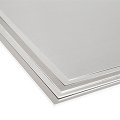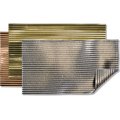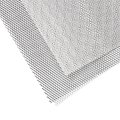Brass Perforated Sheets
Information about brass perforated plates
Etched metal sheet structures are produced through the action of acid on the metal. The sheet, e.g. brass, is first partially covered in an acid resistant "asphalt varnish" or wax and then dipped in an acid bath which either only burns the surface or burns completely through the metal as required. The acid only dissolves the metal in the areas which are not covered. The phenomenon of "undercutting" occurs in the etching process because the acid not only cuts vertically through the metal but also, as soon as the surface has been seared, horizontally as well and this at the same rate. For this reason, the maximum sheet thickness that can be through-cut when only one side of it is covered in the protective varnish is about 0.3 mm.
Etched sheets are relatively expensive for three reasons: the process itself is so elaborate; the number of sheets produced is low; the costs of waste disposal for the used chemicals is extremely high. This, however, does not stop most people from using them in high quality (architectural) model making. The brass sheets can be easily soldered, easily cut with a shears or cutter and can be easily bent to precise shapes. In short, they are easy to work with!




